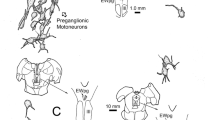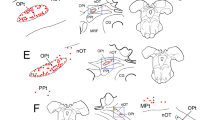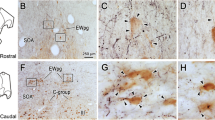Abstract
The pupillary light reflex (PLR) is under the control of retinal ganglion cells projecting to the olivary pretectal nucleus (OPN). The OPN has a major projection to the Edinger-Westphal (EW) nucleus, which exerts its parasympathetic action on the iris musculature via the ciliary ganglion. The accessory oculomotor nuclei (AON) and the periaqueductal gray (PAG) receive input from the OPN and influence the PLR. The present study in rats aimed to elucidate the possible projections from the AON and PAG to the EW nucleus. The anterograde tracer Phaseolus vulgaris leucoagglutinin (PHA-L) was iontophoretically injected into the interstitial nucleus of Cajal (INC), the nucleus of the posterior commissure (NPC), the nucleus of Darkschewitsch (ND) and the rostral part of the PAG. The projections were studied at the light and electron microscopic level. The INC, NPC and ND have small projections to the EW nucleus, whereas the rostral part of the PAG densely projects to the EW nucleus. Without exception INC, NPC, ND and PAG varicosities are presynaptic to dendritic profiles in the EW nucleus and contain electron dense mitochondria, round vesicles and make asymmetric synaptic contacts. In addition the ND and PAG project to the thoracic level of the spinal cord. The fibres are presynaptic to dendritic profiles and contain electron dense mitochondria, round vesicles and make asymmetric synaptic contacts. The present observations allow the conclusion that the parasympathetic preganglionic neurons in the EW nucleus are not only controlled by the OPN-EW pathway but also by indirect pathways running via the AON and PAG. Moreover light-sensitive information is also transferred via an OPN-PAG-spinal cord pathway to the sympathetic superior cervical ganglion (SCG) that innervates the iris, suggesting that the PAG may have an integrative function in the sympathetic and parasympathetic control of the PLR.
Similar content being viewed by others
Author information
Authors and Affiliations
Additional information
Accepted: 2 March 1998
Rights and permissions
About this article
Cite this article
Klooster, J., Vrensen, G. New indirect pathways subserving the pupillary light reflex: projections of the accessory oculomotor nuclei and the periaqueductal gray to the Edinger-Westphal nucleus and the thoracic spinal cord in rats. Anat Embryol 198, 123–132 (1998). https://doi.org/10.1007/s004290050170
Issue Date:
DOI: https://doi.org/10.1007/s004290050170




